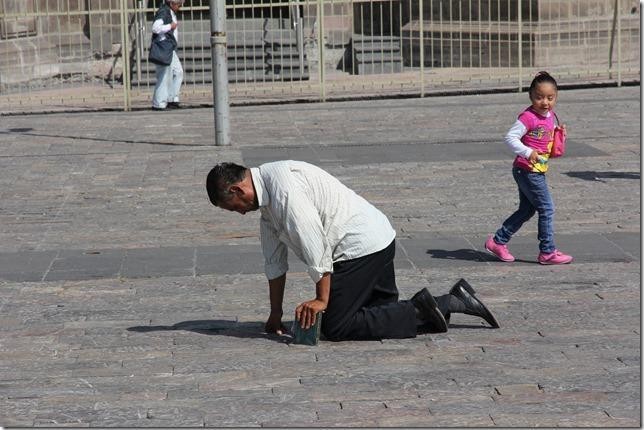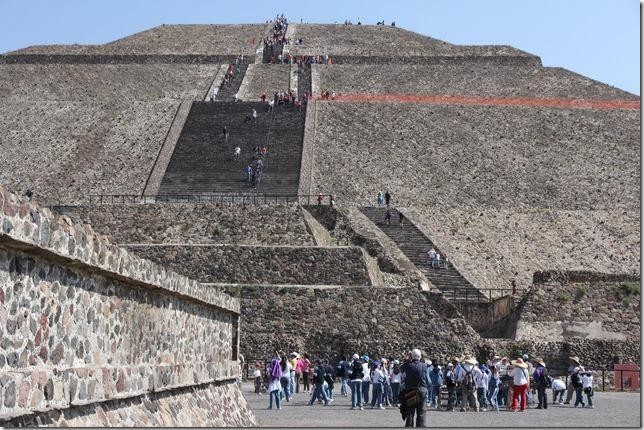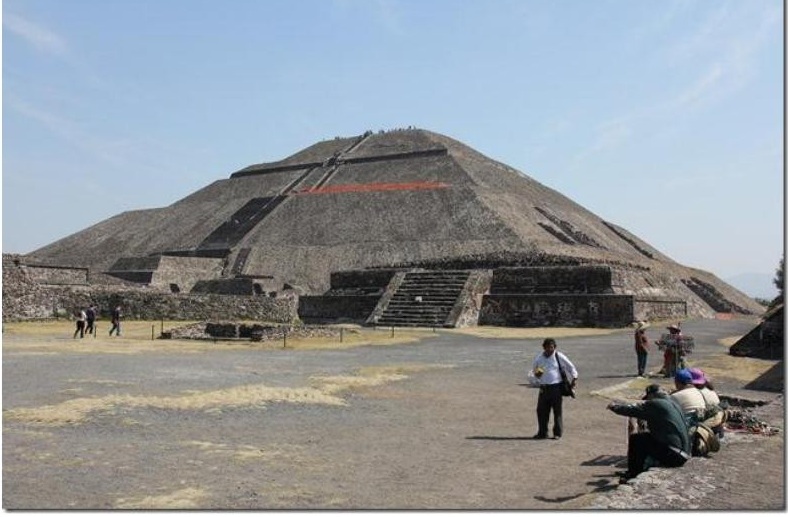By Manzanillo Sun Writer from the June 2014 Edition
Ed: In our previous two sections of Mark’s story we have introduced guides Malena and her husband Hector, who took Mark and Vicky on a very special tour of Mexico City. This is the conclusion of that story.
Malena shared that most of the people making the trek to the Basilica and enduring the crowds are the nation’s poor. They come to ask for that over which they have no control, and to give thanks. Many walk on their knees (sometimes bloodied) near the end of their journey in humbling themselves before God. Observation by the uniformed such as yours truly suggests that the more well to do in Mexico are not too different from those in our home countries. Maybe we sometimes forget to give thanks for what we have, especially when we have plenty?

Witness this man holding a bible and walking several hundred feet on his knees while approaching the new Basilica.
Next was a short 40 km drive to the northeast of Mexico City – Teotihuacan (tay-o- tea-whaw-‘can). Gasps of amazement at the first view of the ‘Pyramid of the Sun’ must be normal (nearby is a similar smaller structure called the Pyramid of the Moon). This major structure was begun sometime before the birth of Christ and completed in approximately 250 AD.
The civilization that created these worship pyramids lasted into maybe the 7th or 8th century. What remains is well cared for and the most visited archaeological site in Mexico. Being the largest pyramid in Mexico, the Pyramid of the Sun is part of structural remnants of an ancient civilization that covers an astonishing total area of 32 sq. miles. Not surprisingly, as of 1987, this area became a UNESCO World Heritage Site, guaranteeing it’s future enjoyment for many generations.

One of our first questions was, “What’s inside?” Turns out the answer is: Everything that could be used to fill up the space – rocks, mud, etc. The structure is near original but did have in addition to what one now sees, a worship temple on top. Bottom line is that this is simply a very big solid pyramid – 438 feet across and almost 250 feet high. It’s a major climb, but one which Vicky and Malena (of course) did with ease. Hector and I agreed to stay on the ground as instructed and take pictures of the two of them on top. http://en.wikipedia.org/wiki/Teotihuacan

Study suggests the culture that built Teotihuacan began possibly 1500 years prior to the Aztecs (250 BC), peaking at about 450 AD after which there seems to be more speculation than fact concerning its demise and timing.
In trying to understand that the inside is simply fill, Hector explained it this way: “Why would you want to go inside anyway? These people worshiped among their God’s, the Sun and the Moon. These pyramids were erected to the God of the Sun and the God of the Moon, and you can’t see these Gods from inside! In addition, the very temperate climate does not require housing to survive, so most living was probably conducted on the ground and/or within a boundary of what was part of a building or improvement”. Our first reaction was then probably somewhat predictable since we of course spend most of our lives and a substantial portion of our earnings trying to get the exact right house in which to live out the rest of our lives (inside).
One must be inclined to ask, what’s so special about the area that comprises Mexico City that 25 million or more people would choose to live in or near this area now and that its’ history extends back for thousands of years? Don’t have the answer exactly and who could in 6 days? For sure it has an ideal climate; must have had resources needed during these millenniums of years; had ample water in a lake surrounded by mountains; became a center of culture; and has had unquestionable beauty. It is now simply there, functioning with a predictable rhythm similar to most cities.
We stayed in an upscale area called Polanco. Without a doubt the pace and services in this special part of the city would rival almost any such upscale area in any of the world’s great cities. Several of the foreign embassies are located in Polanco as are many upscale and expensive apartment complexes. The best in food can be found in Polanco with restaurants of every kind and description. While they serve early birds like us at 6-7 pm, but typical in Spanish cultures, reservations are often required to guarantee access after 9 pm in the evening.
The visit to Mexico City was a great experience and gave us new appreciation for our little town of Manzanillo and its quiet, simple, tropical elegance.
What a contrast, but then that’s part what makes Mexico so special to those who choose to discover its charm. As always the people are gentle and hospitable. We make new friends with each visit. The list of potential places to visit in Mexico is long, but the time is not – we have to ramp up the pace if we’re going to see all that this beautiful country has to offer.
Download the full edition or view it online
Manzanillo Sun’s eMagazine written by local authors about living in Manzanillo and Mexico, since 2009


You must be logged in to post a comment.